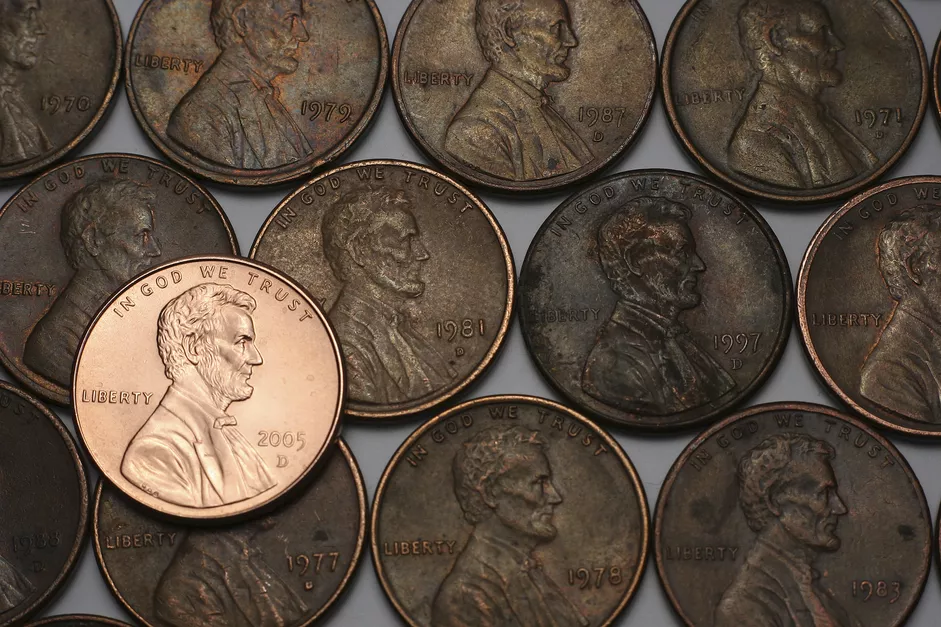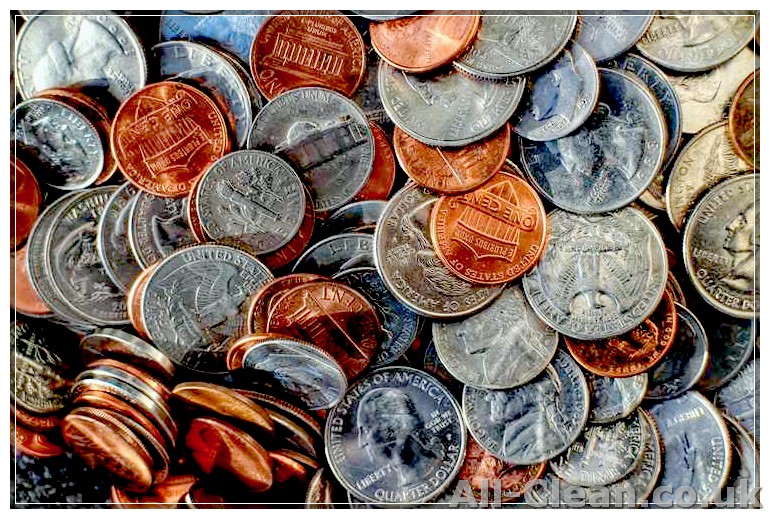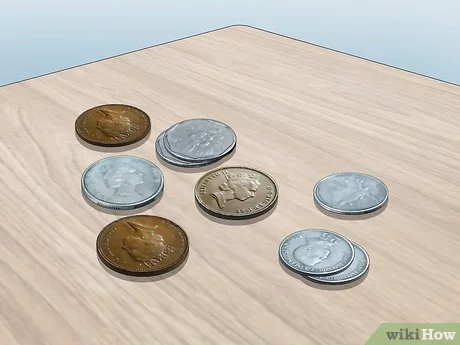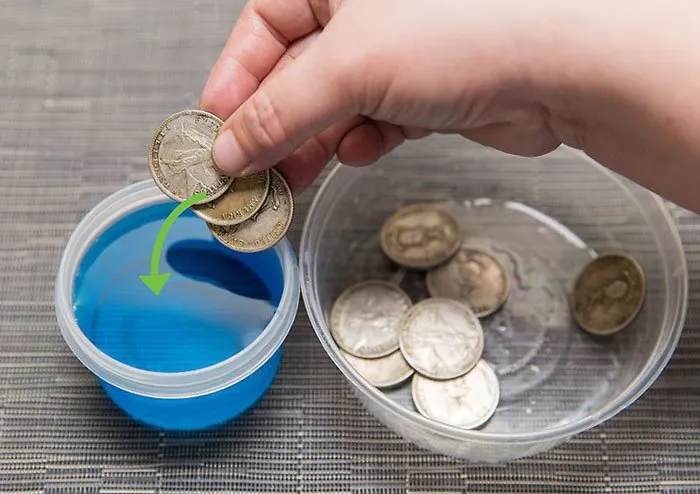
Collecting old coins is a popular hobby among numismatists and history enthusiasts. These small pieces of metal, often discolored with age, hold a white charm and intrigue that cannot be found in modern currency. Although some old coins can be worth a significant amount of money, many collectors simply enjoy the process of uncovering the stories that these inexpensive collectibles carry with them.
Cleaning old coins is a delicate process that requires the right tools and techniques. While there are numerous methods available, one of the most popular choices among beginners is to use toothpaste or oil as a cleaning agent. It is important to note, however, that using the wrong tool or solution can actually do more harm than good, potentially devaluing the coin or even ruining it completely.
When cleaning old coins, it is vital to handle them with care. Old coins are often covered in a layer of dirt, grime, and oxidation that can obscure the coin’s true appearance. Before attempting any cleaning, it is important to remove as much of this crud as possible using mechanical methods such as gentle brushing or wiping with a soft cloth. Once the bulk of the dirt has been removed, the coin can be soaked in a solution such as soap and water, baking soda and water, or another mild cleaning agent to further loosen any remaining residue.
If mechanical cleaning methods have not yielded the desired results, some collectors turn to more advanced techniques such as electrolysis. This method involves the use of an electrolyte solution and a designated anode to attract and remove the dirt and oxidation from the coin. While electrolysis can be an effective cleaning method, it is important to exercise caution and follow expert advice, as improper use of electrolysis can lead to irreversible damage to the coin.
Regardless of the cleaning method chosen, it is important to remember that old coins are delicate artifacts that have survived for centuries. They should be handled with care and respect to ensure their preservation. Whether cleaning to improve their appearance or to potentially increase their value, collectors should always consider the potential risks and consult with experts, such as a coin dealer or professional conservator, before attempting any cleaning process. With proper care and attention, old coins can be restored to their former glory, revealing the fascinating history that lies beneath their tarnished surfaces.
- Importance of Cleaning Old Coins
- Preserving Value
- Enhancing Appearance
- Methods and Techniques
- Expert Tips
- Traditional Cleaning Methods
- Never Soak Coins
- Rubbing Is Not Recommended
- Avoid Windex and Picks
- Use Soft Brushes and Toothpicks
- Consider Vinegar Solution
- Seek Professional Help
- Electrolytic Cleaning: A Revolutionary Technique
- The Steps for Electrolytic Cleaning:
- Precautions and Recommendations for Cleaning Old Coins
- 1. Do Not Use Harsh Chemicals
- 2. Gentle Cleaning Methods
- 3. Soaking Coins
- 4. Using Safe Cleaning Solutions
- 5. Avoid Polishing
- 6. Handling with Care
- 7. Proper Storage
- 8. Seek Professional Advice
Importance of Cleaning Old Coins
When old coins are found in a household, they are often seen as valuable collectibles that could potentially be worth a significant amount of money. However, if these coins are not properly cleaned and maintained, their value may decrease over time. In this article, we will discuss the importance of cleaning old coins and provide expert tips and techniques to help you preserve and enhance their value.
Preserving Value
Old coins that have been stored for weeks, months, or even years can accumulate dirt, grime, and tarnish. This can not only affect their appearance but also corrode the metal, leading to potential damage and a decrease in value. By regularly cleaning your old coins, you can prevent this deterioration, ensuring that they remain in good condition for years to come.
Enhancing Appearance
When selling your old coins to a dealer or collector, the condition and appearance of the coins are crucial factors in determining their value. Cleaning your coins can remove dirt and tarnish, making them more visually appealing and desirable. This can significantly increase their value and make them more attractive to potential buyers.
Methods and Techniques
There are various methods and techniques for cleaning old coins, each with its own advantages and considerations. Some popular methods include using household items such as baking soda, toothpaste, or Windex. These inexpensive solutions are readily available and can be effective in removing dirt and tarnish from coins. However, caution should be exercised as some chemicals may damage the coin’s surface or patina.
For more stubborn dirt and tarnish, professional cleaning machines or electrolysis can be used. Electrolysis involves using an electrical current to remove contaminants. This method should only be performed by experts, as incorrect usage can damage the coin.
Expert Tips
When cleaning old coins, it is important to remember the following tips:
- Use a soft-bristled toothbrush or cotton swab to gently clean the coin’s surface.
- Avoid using excessive pressure, as this can scratch or damage the coin.
- Never clean valuable coins with abrasive materials such as steel wool.
- After cleaning, rinse the coin with distilled water and pat dry with a soft cloth to remove any remaining cleaning solutions or moisture.
- Avoid touching the coin directly with your hands, as the oils on your skin can leave marks and affect its value.
By following these expert tips and using the appropriate cleaning techniques, you can effectively clean old coins while preserving their value and enhancing their appearance. Remember to always do thorough research and consult with professionals before attempting any cleaning method, especially for valuable or rare coins.
Traditional Cleaning Methods
When it comes to cleaning old coins, there are several traditional methods that are commonly used. However, it is important to note that these methods can be risky and may potentially damage the coins, especially if not done correctly. It is recommended to proceed with caution and consider seeking professional assistance for valuable or delicate coins.
Never Soak Coins
One important rule to remember is to never soak coins in any solution. Soaking can lead to the removal of valuable metal and cause the coins to break or become lost forever. This is especially true for gold and other precious metals.
Rubbing Is Not Recommended
While it may be tempting to use rubbing alcohol or other abrasive substances to clean coins, it is generally not recommended. These substances can damage the surface and devalue the coins. It is better to avoid rubbing the coins altogether.
Avoid Windex and Picks

Using household cleaning products such as Windex or metal picks should also be avoided. These products are not designed for cleaning coins and can cause further damage or discoloration.
Use Soft Brushes and Toothpicks
If you really want to attempt cleaning your coins at home, it is best to use soft brushes and toothpicks. Soft brushes can be used to remove loose dirt and debris, while toothpicks can carefully remove any thick dirt or substances. However, extreme caution should be taken to avoid scratching or damaging the coins.
Consider Vinegar Solution

For ancient coins, a vinegar solution can be used to help remove dirt and improve the appearance. However, this should be done with caution, as vinegar can be acidic and potentially cause damage if left for too long. It is important to fully rinse and pat dry the coins after using the vinegar solution.
Seek Professional Help
If you have valuable or collectible coins, or if you are unsure about the best cleaning method to use, it is highly recommended to seek professional assistance. Professional coin cleaners have the necessary knowledge and tools to safely clean and preserve your coins without causing any damage.
Remember, the goal of cleaning old coins is to improve their appearance while preserving their value. So, it is important to weigh the risks before attempting any cleaning method at home.
Electrolytic Cleaning: A Revolutionary Technique
When it comes to cleaning old coins, there are many methods that collectors and enthusiasts employ. However, one technique that stands out as particularly effective is electrolytic cleaning. This method utilizes something called electrolysis to remove dirt, grime, and other contaminants from the surface of coins, leaving them looking brand new once again.
Rather than relying on abrasive agents or harsh chemicals, electrolytic cleaning works by using an electric current to gently and effectively clean the coins. This process is usually done without direct contact with the coin, as it involves the use of a metal (typically steel) that acts as the anode, while the coin is the cathode.
The first step in the electrolytic cleaning process is to create a solution that will facilitate the cleaning. This solution is made using distilled water, which helps to prevent any impurities from interfering with the electrolysis. Other substances, such as baking soda or salt, can also be added to the solution to enhance the cleaning process.
The Steps for Electrolytic Cleaning:
- Create the cleaning solution: Pour distilled water into a container and add a small amount of baking soda or salt. Mix well until the solution is evenly combined.
- Set up the electrolytic cleaning system: Place the dirty, uncleaned coin into the solution, making sure it is fully submerged. Then, carefully position a piece of steel or another metal to act as the anode, ensuring it is not in direct contact with the coin.
- Apply the electric current: Connect the positive terminal of a power supply (such as a battery charger or a variable power supply) to the anode and the negative terminal to the coin. This current will initiate the electrolysis process.
- Let the electrolysis process work its magic: Allow the current to flow through the system for a specific amount of time, depending on the condition of the coin and the desired level of cleaning. This process can take anywhere from a few minutes to several hours.
- Monitor the process: Keep an eye on the coin during the electrolysis process. You should start to see the dirt, grime, and other contaminants loosening and detaching from the coin’s surface.
- Finish with a rinse: Once the desired level of cleaning is achieved, remove the coin from the solution and give it a thorough rinse in clean, warm water. This will help remove any residual cleaning solution and moisture from the coin’s surface.
Electrolytic cleaning has become increasingly popular among coin collectors and enthusiasts due to its effectiveness and relatively low cost. However, it is important to note that this method should only be used on coins that are not inherently valuable, such as those made from copper, silver, or other base metals. Coins made from gold or other precious metals may require different cleaning techniques to avoid potential devaluing.
While electrolytic cleaning can be an attractive option for cleaning heavily tarnished or dirty coins, it is important to approach it with caution. Improper use of electrolysis or extended exposure to the electric current can potentially damage or even ruin the coin. Therefore, it is advisable to start with unimportant or less valuable coins as a “test run” before attempting to clean more valuable or historic pieces.
In conclusion, electrolytic cleaning is a revolutionary technique that uses the power of electrolysis to effectively clean old coins. With the right equipment, materials, and careful monitoring, you can transform your uncleaned coins into shiny, presentable pieces that every collector would be proud to display.
Precautions and Recommendations for Cleaning Old Coins
When it comes to cleaning old coins, there are several precautions and recommendations that you should keep in mind to ensure the preservation of their value and historical significance.
1. Do Not Use Harsh Chemicals
While it may be tempting to use strong cleaning substances, such as acid or bleach, to remove dirt or tarnish from old coins, it is generally not recommended. These chemicals can cause irreversible damage to the coin’s surface and potentially devalue it.
2. Gentle Cleaning Methods
Instead of harsh chemicals, opt for gentle cleaning methods using mild substances. For example, you can use a soft toothbrush and mild soap to gently scrub away dirt and grime. Avoid using abrasive materials or vigorous scrubbing, as this can scratch or damage the coin.
3. Soaking Coins
If your old coin is heavily tarnished or dirty, soaking it in a mild cleaning solution for a short period can help loosen the grime. However, it is important to limit the soaking time and monitor the process closely. Overnight soaking or leaving coins in the solution for a prolonged period can result in damage.
4. Using Safe Cleaning Solutions

To avoid damaging the coin, it is recommended to use safe and non-reactive cleaning solutions. One commonly recommended solution is a mixture of distilled water and mild dish soap. This gentle solution can effectively remove dirt without causing harm to the coin’s surface.
5. Avoid Polishing
Though you may be tempted to polish an old coin to make it shine, it is generally advised to avoid this. Polishing can remove the fine patina that can develop over time and contribute to the coin’s value. It is best to embrace the coin’s natural appearance.
6. Handling with Care
Always handle old coins with clean hands to avoid transferring oils or dirt onto the surface. Hold the coin by its edges and avoid touching the face or any raised areas, as this can cause further damage.
7. Proper Storage

To preserve the value and condition of old coins, it is essential to store them properly. Use archival-quality materials, such as coin flips, to protect them from environmental factors. Additionally, store coins in a cool, dry place to prevent moisture and humidity from causing damage.
8. Seek Professional Advice
If you are unsure about the best cleaning method or have a particularly valuable or ancient coin, it is recommended to seek professional advice. Professional coin dealers or experts in numismatics can guide you on the proper cleaning techniques for preserving the coin’s value.
While cleaning old coins can be tempting, it is crucial to exercise caution to avoid damaging or devaluing these precious collectibles. Following these precautions and recommendations will help ensure the long-term preservation of your coins’ historical and monetary value.








